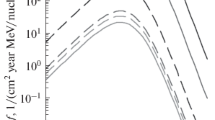Abstract
Identifying the unknown geometric and material information of a multi-shield object by analyzing the radiation signature measurements is always an important problem in national and global security. In order to identify the unknown shielding layer thicknesses of a source/shield system with gamma-ray spectra, we have developed a derivative-free inverse radiation transport model based on a differential evolution algorithm with global and local neighbourhoods (IRT-DEGL). In the present paper, the IRT-DEGL model is further extended for estimating the unknown thicknesses with random initial guesses and material mass densities of multi-shielding layers as well as their combinations. Using the detected gamma-ray spectra, the illustration of inverse studies is implemented and the main influence factors for inverse results are also analyzed.


Similar content being viewed by others
References
G.R. Gilmore, Practical Gamma-Ray Spectrometry, 2nd edn. (Wiley, Chichester, 2008). https://doi.org/10.1002/9780470861981
N.J. McCormick, Inverse radiative transport problems: a review. Nucl. Sci. Eng. 112, 185–198 (1992)
J.A. Favorite, K.C. Bledsoe, Using the Levenberg–Marquardt method for the solution of inverse transport problems. Trans. Am. Nucl. Soc. 95, 527 (2006)
J. Mattingly, D.J. Mitchell, A framework for the solution of inverse radiation transport problems. IEEE Trans. Nucl. Sci. 57, 3734–3743 (2010). https://doi.org/10.1109/NSSMIC.2008.4774636
J.A. Favorite, K.C. Bledsoe, Identification of an unknown material in a radiation shield using the schwinger inverse method. Nucl. Sci. Eng. 152, 106–117 (2006)
K.C. Bledsoe, J.A. Favorite, T. Aldemir, Application of the differential evolution method to solving inverse transport problems. Nucl. Sci. Eng. 169, 208–211 (2011)
K.C. Bledsoe, J.A. Favorite, T. Aldemir, Using the Levenberg–Marquardt method for solutions of inverse transport problems in one- and two-dimensional geometries. Nucl. Technol. 176, 106–126 (2011)
J.C. Armstrong, J.A. Favorite, Identification of unknown interface locations in a source/shield system using the mesh adaptive direct search method. Trans. Am. Nucl. Soc. 107, 375–377 (2012)
S.J. Norton, A general nonlinear inverse transport algorithm using forward and adjoint flux computations. IEEE Trans. Nucl. Sci. 44, 153–162 (1997). https://doi.org/10.1109/23.568797
K.C. Bledsoe, J.A. Favorite, Using the Marquardt method for solution of inverse transport problems in two-dimensional cylinders. Trans. Am. Nucl. Soc. 98, 591 (2008)
J. Mattingly, D.J. Mitchell, Implementation and testing of a multivariate inverse radiation transport solver. Appl. Radiat. Isotopes 70, 1136–1140 (2012). https://doi.org/10.1016/j.apradiso.2011.10.020
K.C. Bledsoe, J.A. Favorite, T. Aldemir, A comparison of the covariance matrix adaptation evolution strategy and the Levenberg–Marquardt method for solving multidimensional inverse transport problems. Ann. Nucl. Eng. 38, 897–904 (2011). https://doi.org/10.1016/j.anucene.2010.09.014
K.C. Bledsoe, Inverse methods for radiation transport. Ph.D Thesis, Ohio State University (2009)
S. Das, A. Abraham, U.K. Chakraborty et al., Differential evolution using a neighborhood-based mutation operator. IEEE Trans. Evol. Comput. 3, 526–553 (2009). https://doi.org/10.1109/TEVC.2008.2009457
P.N. Suganthan, Differential evolution algorithm: recent advances. Lect. Notes Comput. Sci. 7505, 47–56 (2012)
Y. Chen, L.P. Zhang, X. Sai et al., An enhanced differential evolution-based inverse radiation transport model for identification of unknown shielding layer thicknesses with gamma-ray spectrum. Nucl. Sci. Technol. 28, 84 (2017). https://doi.org/10.1007/s41365-017-0231-x
Mcnp-a gereral monte carlo n-particle transport code, version 5. X-5 Monte Carlo Team, LA-CP-03-0245, Los Alamos National Laboratory (2003)
Author information
Authors and Affiliations
Corresponding author
Additional information
This work was supported by the National Natural Science Foundation of China (Nos. 11605163 and 21504085), the China Academy of Engineering Physics Foundation for Development of Science and Technology (No. 2015B0103014 and No. 2015B0301063), the Foundation for Special Talents in China Academy of Engineering Physics (No. TP201502-3), and the Sichuan Science and Technology Development Foundation for Young Scientists (No. 2017Q0050).
Rights and permissions
About this article
Cite this article
Chen, Y., Zhang, LP., Xiao, S. et al. Identification of the unknown shielding parameters with gamma-ray spectrum using a derivative-free inverse radiation transport model. NUCL SCI TECH 29, 70 (2018). https://doi.org/10.1007/s41365-018-0401-5
Received:
Revised:
Accepted:
Published:
DOI: https://doi.org/10.1007/s41365-018-0401-5




